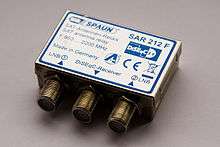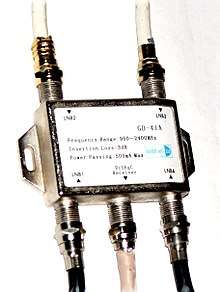DiSEqC
DiSEqC (Digital Satellite Equipment Control), pronounced "Die-Sec", is a special communication protocol for use between a satellite receiver and a device such as a multi-dish switch or a small[1] dish antenna rotor. DiSEqC was developed by European satellite provider Eutelsat, which now acts as the standards agency for the protocol.



History
Eutelsat apparently developed the system to allow satellite users in Continental Europe to switch between the more popular SES Astra satellites at 19.2° east and Eutelsat's own Hot Bird system at 13° east. As a result, the vast majority of European satellite receivers support DiSEqC 1.0 or higher, with the exception of all set top boxes manufactured under the Sky Digibox name. All supporting receivers have received certification to carry a logo specifying which variation of DiSEqC they support.
Protocol
DiSEqC relies only upon a coaxial cable to transmit both bidirectional data/signals and power. DiSEqC is commonly used to control switches and motors, and is more flexible than 13/18 Volt and 22 kHz tone or ToneBurst/MiniDiSEqC techniques. DiSEqC is also compatible with the actuators used to rotate large C band dishes if used with a DiSEqC positioner. DiSEqC uses a pulsed (tone-burst) 22 kHz sine-wave at 0.65 V (± 0.25 V)[2] peak to peak.
The "Di" (digital) part of the name refers to the digital nature of the signals used by the protocol and does not imply anything about the transmission that the dish is used to receive; DiSEqC may be used with both digital or analogue satellite systems.
Versions and compatibility
A number of versions of DiSEqC exist:
- DiSEqC 1.0, which allows switching between up to 4 satellite sources
- DiSEqC 1.1, which allows switching between up to 16 sources
- DiSEqC 1.2, which allows switching between up to 16 sources, and control of a single axis satellite motor
- DiSEqC 2.0, which adds bi-directional communications to DiSEqC 1.0
- DiSEqC 2.1, which adds bi-directional communications to DiSEqC 1.1
- DiSEqC 2.2, which adds bi-directional communications to DiSEqC 1.2
- DiSEqC 3.0, which adds remote management of receivers to DiSEqC 2.2 to enable broadcast house uses
First four variations were standardized by February 1998, prior to general use of digital satellite television. The later versions are backwards compatible with the lower revisions, but the lower revisions are, as might be expected, not forwards compatible with the higher revision numbers. 1.x and 2.x versions are both backwards and forwards compatible.
The terms DiSEqC 1.3 and 2.3 are also often used by manufacturers and retailers to refer to the use of DiSEqC with other protocols. For example, 1.3 usually refers to a receiver which uses USALS in conjunction with the DiSEqC 1.2 protocol. Such terminology has not been authorised by Eutelsat.
The following table shows compatibility between the various DiSEqC versions:
| 1.0 switch | 1.1 switch | 1.2 motor | 2.0 switch | 2.1 switch | 2.2 motor | 3.0 receiver | 3.0 antenna-side | |
|---|---|---|---|---|---|---|---|---|
| 1.0 receiver | Yes | No | No | Yes | No | No | Yes | No |
| 1.1 receiver | Yes | Yes | No | Yes | Yes | No | Yes | No |
| 1.2 receiver | Yes | Yes | Yes | Yes | Yes | Yes | Yes | No |
| 2.0 receiver | Yes | No | No | Yes | No | No | Yes | No |
| 2.1 receiver | Yes | Yes | No | Yes | Yes | No | Yes | No |
| 2.2 receiver | Yes | Yes | Yes | Yes | Yes | Yes | Yes | No |
| 3.0 broadcast house | No | No | No | No | No | No | Yes | Yes |
| 3.0 antenna-side | Yes | Yes | Yes | Yes | Yes | Yes | Yes | Yes |
NOTE: a 1.x receiver will not be able to receive communication from a switch or motor. Usually this is not important, as the switch or motor can be controlled by the receiver without problems.
See also
- USALS
- SES
- Astra
- Eutelsat
- Astra 19.2°E
Notes
- The maximum dish size that can generally be used with a DiSEqC motor is 1.2m; however, using a V-box as in interface, DiSEqC 1.2 can be used for very large dishes using 36V motors.
- "Digital Satellite Equipment Control (DiSEqC) Bus Functional Specification (Version 4.2)" (PDF). Eutelsat. 1998-02-25. Retrieved 2012-04-18.
External links
- DiSEqC.org specifications (.
- DiSEqC schematic
- DiSEqC specs (retrieved from Internet Archive)
- DiSEqC Bus Functional Specification Version 4.2 (bus_spec.pdf contained in DiSEqC-documentation.zip)